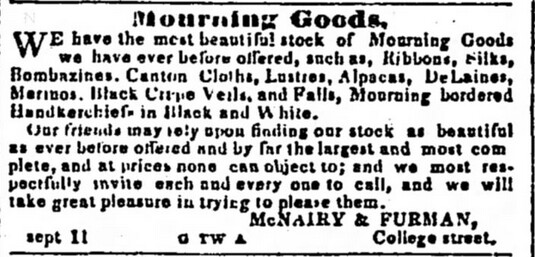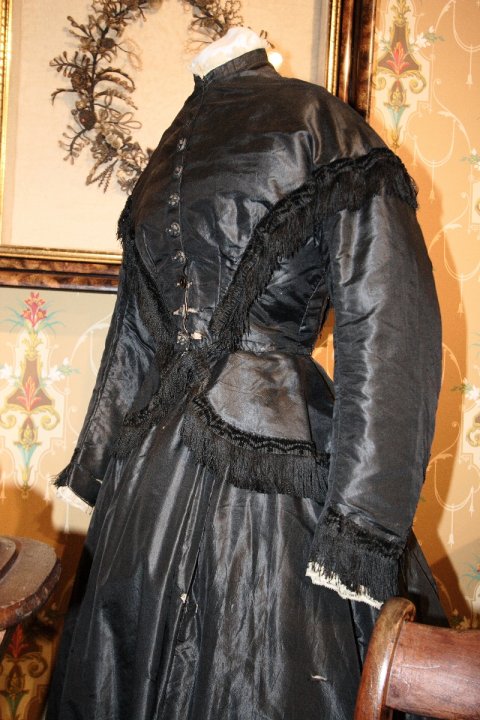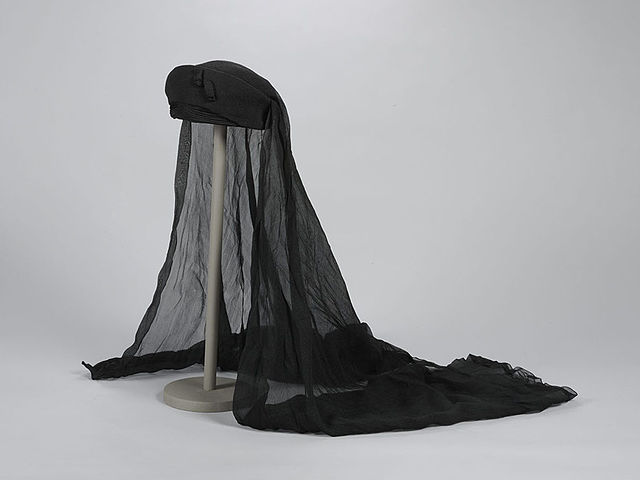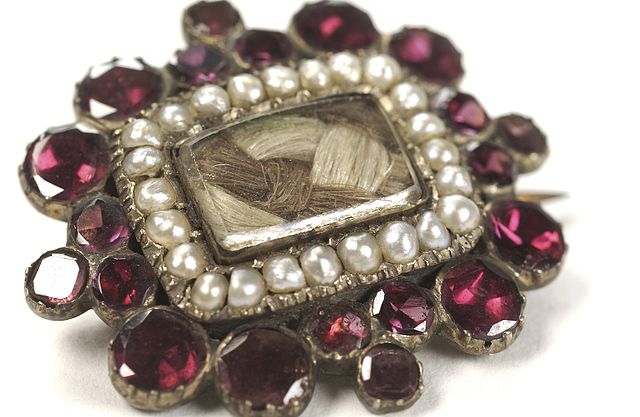Republican Banner and Nashville Whig, 21 January 1853, page 3
Republican Banner and Nashville Whig, 21 January 1853, page 4
Mourning traditions became more elaborate after Queen Victoria's husband Prince Albert died in 1861; she mourned for the rest of her life.
Nashville Union, 25 July 1863, page 2
Women were required to express grief for a longer period than men.Widows could spend two and a half years in mourning, but widowers might grieve for three months. A woman would mourn longest for a spouse; the length of time spent in mourning for other family members depended on the relationship to the deceased. For example, a woman would spend a longer time in mourning for a parent than for a cousin.
Mourning was expensive, because the required clothes had to be fashionable. Black clothes were to be worn at first. Many of them were made of crape (the word was spelled crape, not crêpe, when it was associated with mourning.)
Woman's mourning dress (1867-1869): silk bodice and skirt with black fringe, white lace cuffs, and white gauze collar. Museum of Funeral Customs, Springfield, Illinois, 2006. Photo by Robert Lawton [CC BY-SA 2.5 (https://creativecommons.org/licenses/by-sa/2.5/)]. Available from Wikimedia Commons.
Women wore black veils when they left their homes.
Black toque hat, with black veil. Mourning hat. Musées de la Haute-Saône. Photo by Jacques Monnin [CC BY-SA 3.0 (http://creativecommons.org/licenses/by-sa/3.0)]. Available from Wikimedia Commons.
Bonnets were worn instead of hats.
Woman's Bonnet (Mourning), 1880s. Los Angeles County Museum of Art. Gift of Mrs. Margaret Elm Bryner. Public domain. Available from Wikimedia Commons.
During half mourning, the last part of the mourning period, other colors besides black could be worn. Colors such as gray, purple, mauve, and white were gradually mixed in.
Jewelry also had to be appropriate for mourning.
Mourning jewelry, brooch, jet, 19th c. Photo by Detlef Thomas [CC BY-SA 2.0 de (http://creativecommons.org/licenses/by-sa/2.0/de/deed.en)]. Available from Wikimedia Commons.
Mourners sometimes wore jewelry which contained hair from the deceased relative.
Mourning brooch containing the hair of a deceased relative. Photo number: L0036393. Library reference: Museum No A71928. Wellcome Library, London [CC BY 4.0 (http://creativecommons.org/licenses/by/4.0)]. Available from Wellcome Images and Wikimedia Commons.
References
Janney, Caroline E. Mourning during the Civil War. Encyclopedia of Virginia.
Mourning
19th Century Mourning Practices (revised)
Shubert, Betty Kreisel. Out-of-Style: A Modern Perspective of How, Why, and When Vintage Fashions Evolved. Mission Viejo, CA: Flashback Publishing, 2013.
Thomas, Pauline Weston. Mourning Fashion History









No comments:
Post a Comment